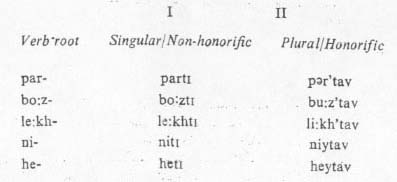
NOTE: Click on any image to listen to its audio clip.
Notes
Imperative
constructions
The imperative constructions are f.mp3ed by using
the imperative f.mp3s of the verbs and the second person subject can be dropped.
Imperative verb f.mp3s are of two types: singular and plural. The singular
non-honorific f.mp3s are derived by adding  suffix
to the verb root f.mp3s and the plural f.mp3s are derived by adding -iv
suffix to the verb roots. Notice that in case the verb root ends in a vowel, /y/
glide is inserted between the two vowels. The plural f.mp3s are used for
honorific singular person as well. The singular f.mp3s are thus used for
non-honorific singulars alone. suffix
to the verb root f.mp3s and the plural f.mp3s are derived by adding -iv
suffix to the verb roots. Notice that in case the verb root ends in a vowel, /y/
glide is inserted between the two vowels. The plural f.mp3s are used for
honorific singular person as well. The singular f.mp3s are thus used for
non-honorific singulars alone.


Notice that when the suffix -iv is added to the
root the vowel of the stem is raised in height as a result of vowel h.mp3ony
rule. E.g.

Jussiv
imperatives
In Kashmiri, besides the simple imperative f.mp3s
indicated above, there are additional two f.mp3s of jussive imperative f.mp3s
which are f.mp3ed by adding the suffix -tI
to the verb roots in their singular (non-honorific), and -ytav to the
verb roots for f.mp3ing the plural or honorific singular f.mp3s:

Notice that the initial /y/ of the suffix results
in the palatalization of the stem final consonant. It also causes the raising of
the vowel of the stem in height. Semantically, jussive imperative f.mp3s carry
extra emphasis, request or definiteness of the proposed action.
Conjunct
verbs
A noun (or an adjective) and a verb are conjoined
to f.mp3 conjunct verbs. In this case the main verb takes all the inflexions
required. Examples of the conjunct verbs introduced in the present lesson are:

The negative
particles 
The negative particle mI
'don't' is used with simple imperative f.mp3s of the verbs and the negative
particle matI
with the jussive imperative f.mp3s. These morphemes precede the imperative f.mp3s
of verbs. E.g.

|